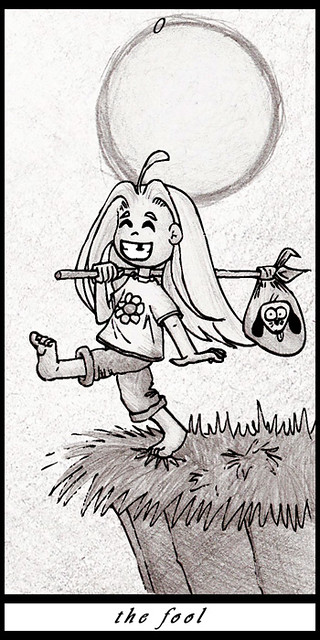 |
| Leo Karchesky/flickr.com |
First drafts of even the best-planned novels offer some surprises to the writer along the way, and this book did not start out as one of the best-planned novels I've ever attempted. So I was surprised when I realized my protagonist, whose name is Julia, is on a Fool's Journey. I mean, I wanted to work a labyrinth into the story, and I intended for the action to stretch over the course of a year. And I had the setting all picked out (more on that in weeks to come). But when Julia first stepped into the labyrinth and found herself at the edge of a cliff, with a little dog nipping at her heels...well, I had to sit back for a minute. Because that's the scene depicted in Card Zero -- also known as The Fool -- of the Major Arcana in a Tarot deck.
A typical Tarot deck is made up of 78 cards. Fifty-six of them are split into four suits, similar to a regular deck of playing cards, and in fact you can match up the suits in a Tarot deck with the suits in a playing card deck: Wands (Clubs), Swords (Spades), Cups (Hearts), and Pentacles (Diamonds). Each suit in a Tarot deck has 14 cards: Ace through 10, Page, Knight, Queen, and King. So that, too, is similar to a deck of playing cards, except for the addition of the Page.
Those 56 cards are collectively called the Minor Arcana. The remaining 22 cards, the Major Arcana, have no corresponding cards in a regular deck -- except for The Fool, which evolved into the Joker.
Now, sometimes people get a little nervous when you start talking about the Tarot. The first thing they think of is gypsy fortune-tellers and "Cross my palm with silver" and all that junk. Yes, you can use the Tarot for divination, if you're so inclined. But the cards can also be used as a springboard for meditation, and as a tool for self-discovery.
That's where the Journey of the Fool comes in. Many folks over the years have strung together a narrative that likens the progression of cards in the Major Arcana to a journey through life. You can take the journey yourself. One technique is to pick a day each month on which you will sit down, clear your mind, imagine yourself in the scene of one of the Major Arcana cards -- starting with The Fool and taking each card in order, all the way to Card 21, The World -- and see what your subconscious spits out at you. (Fun fact: Going through this exercise is what convinced me to start writing seriously.)
I'm not going to step Julia through every card in the Major Arcana, but I am keeping the cards in order. It's been an interesting exercise so far, and it promises to get extremely interesting shortly. She hasn't gotten to The Tower yet.
***
Speaking of life's journeys, I was saddened to learn this week of the passing of one of my favorite authors. Graham Joyce was a British author who wrote dark fantasy; I stumbled across his work in my local library one day and, once begun, gobbled his books as fast as I could. His work was better known in the U.K. than here in the States, and I've always thought that was a shame.
I met him at the World Fantasy Convention in San Diego in 2011. The Silent Land had just come out; he signed my copy for me, and showed me a cool thing about the dust jacket design (ping me in the comments, and I'll tell you what it is). Just a nice guy.
I loved The Silent Land, but my favorite book of his is probably still The Tooth Fairy. Really, all of his work is excellent. I'm so sorry that he's gone. RIP, Graham.
***
These moments of Foolish blogginess have been brought to you, as a public service, by Lynne Cantwell.

No comments:
Post a Comment